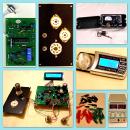Full manual available here:
https://www.radioelec.com/images/Image/Documentation/Notice%20Oeil%20magique.pdf
You can see it working here:
https://drive.google.com/file/d/1-3-23FoDNMWeZ9fmvgIzoBGm5I9mOdZk/view?pli=1
Features :
- Electronic tuning indicator with double sensitivity equiped of a LCD screen
- Closing the first sector - 3.5 / - 4 V adjustable
- Closing second sector - 15 V / - 16 V adjustable
- Input Impedance: 50 MOhm minimum
- Colour of the programmable eye: red, cyan, blue, yellow, green, white.
- Frequency : efficient with possibility to programm a offset frequency + or - to the measured frequency.
Measuring range : 0 to 6500 kHz
Input impedance of the frequency : 1 MOhm
Sensitivity : 30 to 100 mVcc depending on the frequency
Maximum applicable voltage : 500 V
Programmable display
- Voltmeter:
Measuring range: 0 to 800 V
Input Impedance 1 MOhm
Programmable display
- Dimensions:
Eye diameter 25 mm
Screen : 30 x 36 mm useful / 31 x 45 mm overall
Total length: 67 mm
Maximum Height: 45 mm over a length of 22 mm and 35 mm
Overall Thickness: 32 mm
- Connections:
Powered by the voltage of the filament as a traditional magic eye and requires no high voltage
* 6.3 VL 6.3 V ac (less than 100 mA consumption) or 6 to 12 V DC
6.3 V * H: 6.3 V ac or 6 to 12 V DC
* GRID: Voltage eye control (grid pin of the magic eye)
* FIN: Input frequency
* GND: Body receptor (cathode pin of the magic eye)
* +HT + Entry voltmeter
- Programming colors and display mode stored in memory even after power failure.
The base color is a green identical to the green eye cathode, the brightness is constant, very comfortable and does not deteriorate with time.
- Connections by wires, an octal plug is available on request, the end of the eye can be embedded in it.
Uses :
- Easy to install, this module can permanently replace any type of magic eye circular as EM34, EM4, 6AF7 ...
- The eye takes the appearance and colors desired : single eye (no numerical data) or display of all or part of the measurement functions with two font sizes to choose.
- Frequency allowing for example, to display the frequency of received stations by connecting to the local receiver oscillator, the frequency offset will be programmed with the value of the intermediate frequency.
- Voltmeter allowing for example, to know the value of the high voltage of the receiver.










![]()
![]()
![]()
![]()
![]()

